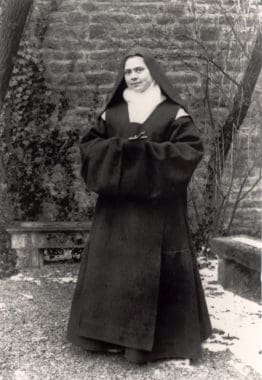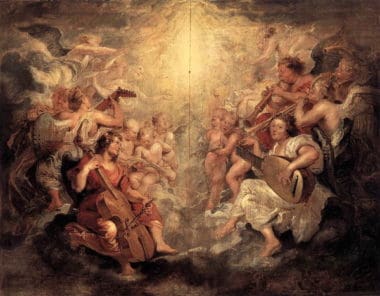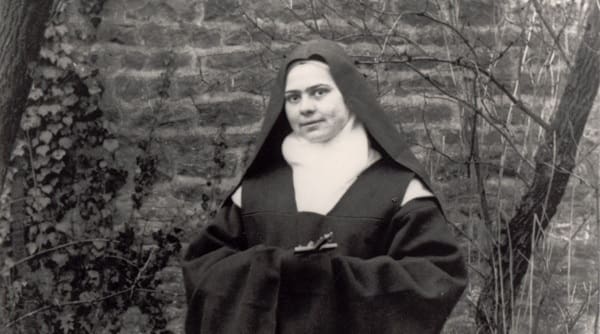Blessed Elisabeth of the Trinity – On the Meaning of Life
 For Blessed Elisabeth, the beginning and end of human life is a great hymn of praise. She held this as true for her married sister, a young mother, as she did for her fellow Carmelite nuns. She boldly affirmed that the very source of our existence is in the Son whose mysterious canticle of praise to the Father is the source of eternal joy.
For Blessed Elisabeth, the beginning and end of human life is a great hymn of praise. She held this as true for her married sister, a young mother, as she did for her fellow Carmelite nuns. She boldly affirmed that the very source of our existence is in the Son whose mysterious canticle of praise to the Father is the source of eternal joy.
She contemplated the Word of the Father as the Divine Archetype of humanity. She was convinced that because we are in His image and because He has redeemed us by His blood, we have access to this great hymn when we draw close to the Cross of Christ by faith. In her biblical vision of the cosmos, those who pass through the great tribulation of Christ’s passion also raise this great hymn of praise before the throne of the Lamb – unvanquished and victorious forever.
She is emphatic that the wonder of this music has a nuptial quality. Exchanged between Bride and Bridegroom not only in the life to come, but already right now, in this present moment, where eternity is already begun. Its melody is unfamiliar and strange: I no longer know anything, she sings. And yet, its content is painfully revealed: but Christ crucified, she insists.
The knowledge of this music is not reducible to an intellectual insight or a feeling or even a new state of consciousness. It is ou humanity completely surrendered and lifted up by God into total union, total forgetfulness of self, total awareness of the Lord. Everything is in the shadow of Christ crucified by love, everything a response, a “thank you” for the immensity of love that He has revealed. Wholly attentive and adoring, a soul that is drawn out of itself by the love of the Lord is vulnerable and ready for a beautiful encounter, for the impact of Divinity into the frailty of humanity.
 How can this vision of Blessed Elisabeth’s be true for both the married and for those who have renounced marriage? The whole world is animated by an eternal Sanctus. So in marriage, and so in consecrated life, Divine harmonies are not only meant to live in the human heart – they are meant to be the very life of the soul. She describes our hearts as a kind of interior lyre whose strings we must tune by renunciation and perseverance in trial. This means, over and above everything else, in whatever our vocation, being faithful to the truth that God is love and, in this faithfulness, choosing in each moment to live by His love.
How can this vision of Blessed Elisabeth’s be true for both the married and for those who have renounced marriage? The whole world is animated by an eternal Sanctus. So in marriage, and so in consecrated life, Divine harmonies are not only meant to live in the human heart – they are meant to be the very life of the soul. She describes our hearts as a kind of interior lyre whose strings we must tune by renunciation and perseverance in trial. This means, over and above everything else, in whatever our vocation, being faithful to the truth that God is love and, in this faithfulness, choosing in each moment to live by His love.
Blessed Elisabeth rejoiced that her sister had found someone to love. She also yearned to be a Bride for the heart of Christ. Behind her thought is a primordial conviction that Bride and Bridegroom together in unity stand at the height and in the foundation of all the living things that God has summoned into existence in the visible world. Made for one another, their union is not accidental to His purpose. They bear witness to a nuptial mystery written in the very heart of creation from the very depths of God. It is with this same devotion that Blessed Elisabeth lived her life for the Lord – the music of love that resonates in the sanctity of marriage also moves those who renounce marriage for the sake of the Lord alone.
Blessed Elisabeth’s life as a contemplative consecrated to God bears witness to the magnificence of this mystery. It did not diminish friendship, but opened it up and made it all the more beautiful in her life. When friends bound by love glimpse Him, the music of His very heart stirs them into life, a mutual surrender to one another that holds nothing back. When they live life to the full in this way, it is to the praise of His Glory and new life is born. What is true in marriage is true also in a life consecrated to God: Love seeks Him, and living by love praises Him. The humble efforts toward this in marriage are the very shadows of a mystery for which contemplatives, like Blessed Elisabeth, are the living signs.
Whether married or consecrated, when we make space for God, our lives are carried by a kind of interior music. At once prayerful, faithful, fertile and industrious, a great harmony of hope compels us to know God and one  another, and to be known, to be loved and to love. In this union of mutual knowledge and love we find the freedom to give ourselves, and in this gift, the mystery of our existence discloses itself and the truth about God is given to us. For Blessed Elisabeth, to surrender ourselves in love is to join the Great Canticle echoing from the foundation of the world and resounding in the heights of heaven: the very praise of the glory of God’s merciful love.
another, and to be known, to be loved and to love. In this union of mutual knowledge and love we find the freedom to give ourselves, and in this gift, the mystery of our existence discloses itself and the truth about God is given to us. For Blessed Elisabeth, to surrender ourselves in love is to join the Great Canticle echoing from the foundation of the world and resounding in the heights of heaven: the very praise of the glory of God’s merciful love.
Editor’s Note: As Dr. Lilles reported last week, on March 4th, Pope Francis approved the second miracle required for the canonization of Blessed Elizabeth. A formal announcement of the date for her canonization is expected in the next few weeks.
+
For more of Anthony’s insights on prayer, don’t miss his book, Hidden Mountain Secret Garden, an experience like no other. Anthony has an unusually profound understanding of mystical theology and lives a life of deep prayer. Among his many accomplishments and responsibilities, Dr. Lilles now teaches theology for the Avila Institute.
+
Art: Full Portrait Picture of Elisabeth of the Trinity wearing her Carmelite Habit, Willuconquer picture, 29 January 2011, original picture undated, CCA-SA; Partial restoration of Music Making Angels, Peter Paul Reubens, circa 1628, PD-US author’s life plus 100 years or less; Detail of The Ghent Altarpiece: Singing Angels, Jan van Eyck, between 1427 and 1429, author’s life plus 100 years or less; all Wikimedia Commons.





